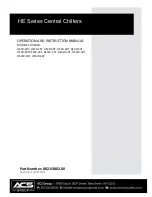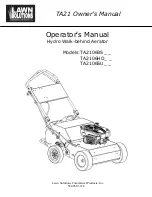
SYSTEM SERVICE
NOTE: Service on this equipment is to be performed by qualified refrigeration personnel. Causes for repeated tripping of safety
controls must be investigated and corrected. CAUTION: Disconnect all power before doing any service inside the unit.
FILTER-DRIERS
To change the filter-drier, pump each refrigerant circuit down
by closing the manual liquid line shutoff valve while a com-
pressor is running. After both refrigerant circuits are pumped
down, move the system switch to the “Emergency Stop” posi-
tion. This will remove all liquid refrigerant from the evaporator
and section of liquid line up to the shutoff valve. Only a small
amount of vapor will remain in the liquid line/filter-drier sec-
tion. Front seat the compressor suction valve(s), Remove and
replace the filter-drier(s). Evacuate the lines through the li-
quid line manual shutoff valves to remove non-condensables
that may have entered during filter replacement. A leak check
is recommended before returning the unit to operation.
NOTE: On Arrangement A units, the filter-drier cores are shipped in the unit
control box and are to be Installed prior to evacuating and charging the unit.
LIQUID LINE SOLENOID VALVE
The liquid line solenoid valves, which are responsible for
automatic pumpdown during normal unit operation, do not
normally require any maintenance. However, in the event of
failure they may require replacement of the solenoid coil or
of the entire valve assembly.
The solenoid coil may be removed from the valve body
without opening the refrigerant piping by moving Circuit 1 and
Circuit 2 switches to the “Pumpdown and Stop” position.
The coil can then be removed from the valve body by simply
removing a nut or snap-ring located at the top of the coil. The
coil can then be slipped off its mounting stud for replacement.
Be sure to replace the coil on its mounting stud before return-
ing the unit to operation.
To replace the entire solenoid valve, follow the steps involv-
ed when changing a filter-drier.
THERMOSTATIC EXPANSION VALVE
The expansion valve is responsible for allowing the proper
amount of refrigerant to enter the evaporator regardless of
cooling load. It does this by maintaining a constant superheat.
(Superheat is the difference between refrigerant temperature
as it leaves the evaporator and the saturation temperature cor-
responding to the evaporator pressure.) All WHR chillers are
factory set for between 8°F and 12°F superheat at full load.
If it is necessary to increase the superheat setting of the valve,
remove the cap at the bottom of the valve to expose the ad-
justment screw. Turn the screw clockwise (when viewed from
the adjustment screw end) to increase the superheat and
counterclockwise to reduce superheat. Allow time for system
rebalance after each superheat adjustment.
The expansion valve, like the solenoid valve, should not nor-
mally require replacement, but if it does, the unit must be
pumped down by following the steps involved when chang-
ing a filter-drier.
If the problem can be traced to the power element only,
it can be unscrewed from the valve body without removing
the valve, but only after pumping the unit down.
WARNING: Adjustment of expansion valve should only be
performed by a qualified service technician.
Figure
30.
Inlet
Power Element
(Contains Diaphragm)
Adjustment Screw
NOTE: Superheat
vary with compressor unloading, but should be approx-
imately as follows- between 6°F and 12°F at full load; between 6°F and 10°F
at part load.
EVAPORATOR
The evaporator is of the direct expansion, shell-and-tube type
with refrigerant flowing through the tubes and water flowing
through the shell over the tubes. The tubes are internally
finned to provide extended surface as well as turbulent flow
of refrigerant through the tubes. Normally no service work is
required on the evaporator. There may be instances where
a tube will leak refrigerant into the water side of the system.
In the cases where only one or two tubes leak, the problem
can best be solved by plugging the tube at both ends. When
the tube must be replaced, the old tube can be removed and
replaced.
To remove a tube, the unit should be temporarily pumped
down. Follow the steps involved when changing a filter-drier.
These steps will insure a minimum amount of refrigerant loss
when the evaporator is opened up. The tubes are mechanical-
ly expanded into the tube sheets (see Figure 31) at each end
of the cooler. In order to remove the tubes, it is necessary
to break this bond by collapsing the tube. After doing this at
both ends of the shell, the tube can be removed for replace-
ment. The new tube can then be inserted and re-expanded
into the tube sheet.
NOTE: The bond produced by expansion must be refrig-
erant tight. This bond must be produced by applying Locktite
(red) to the
and rolling it into the
sheet.
IM 508 Page 45
Summary of Contents for WHR 040
Page 1: ......
Page 2: ......
Page 5: ......
Page 9: ......
Page 15: ......
Page 16: ......
Page 17: ......
Page 18: ......
Page 19: ......
Page 20: ......
Page 21: ......
Page 22: ......
Page 23: ......
Page 24: ......
Page 25: ......
Page 26: ......
Page 27: ......
Page 28: ......
Page 30: ......
Page 31: ......
Page 32: ......
Page 33: ......
Page 34: ......
Page 35: ......
Page 36: ......
Page 37: ......
Page 38: ......
Page 39: ......
Page 40: ......
Page 41: ......





































